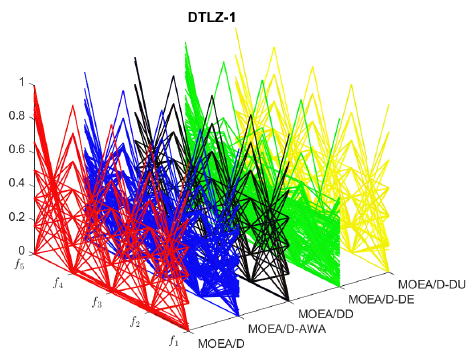Comparando Algoritmos Evolutivos Baseados em Decomposição para Problemas de Otimização Multiobjetivo e com Muitos Objetivos
DOI:
https://doi.org/10.14295/vetor.v33i2.16444Palavras-chave:
Algoritmo Evolutivo, Decomposição, Otimização MultiobjetivoResumo
Muitos problemas oriundos do mundo real podem ser modelados matematicamente como Problemas de Otimização Multiobjetivo (POMs), já que possuem diversas funções objetivo conflitantes entre si que devem ser minimizadas simultaneamente. POMs com mais de 3 funções objetivo recebem o nome de Problemas de Otimização com Muitos Objetivos (MaOPs, do inglês Many-objective Optimization Problems). Os POMs geralmente são resolvidos através de Algoritmos Evolutivos Multiobjetivos (MOEAs, do inglês Multiobjective Evolutionary Algorithms), os quais conseguem obter um conjunto de soluções ótimas não dominadas entre si, conhecidos como frente de Pareto, em uma única execução. O MOEA baseado em decomposição (MOEA/D) é um dos mais eficientes, o qual divide um POM em vários subproblemas monobjetivos otimizando-os ao mesmo tempo. Neste estudo foi realizada uma avaliação dos desempenhos do MOEA/D e quatro de suas variantes que representam o estado da arte da literatura (MOEA/DD, MOEA/D-DE, MOEA/D-DU e MOEA/D-AWA) em POMs e MaOPs. Foram conduzidos experimentos computacionais utilizando POMs e MaOPs benchmark do suite DTLZ considerando 3 e 5 funções objetivo. Além disso, foi realizada uma análise estatística que incluiu o teste de Wilcoxon para avaliar os resultados obtidos no indicador de desempenho IGD+. Também foi considerado o indicador de desempenho Hypervolume na frente de Pareto combinada, que é formada por todas as soluções obtidas por cada MOEA. Os experimentos revelaram que o MOEA/DD apresentou a melhor performance no IGD+ e o MOEA/D-AWA obteve o maior Hypervolume na frente de Pareto combinada, enquanto o MOEA/D-DE registrou o pior resultado nesse conjunto de problemas.Downloads
Referências
K. Deb, Multiobjective Evolutionary Algorithms. John Wiley & Sons, 2001.
Q. Zhang and H. Li, “MOEA/D: A multiobjective evolutionary algorithm based on decomposition,” IEEE Transactions on Evolutionary Computation, vol. 11, no. 6, pp. 712–731, 2007. Available at: https://doi.org/10.1109/TEVC.2007.892759
Q. Xu, Z. Xu, and T. Ma, “A survey of multiobjective evolutionary algorithms based on decomposition: variants, challenges and future directions,” IEEE Access, vol. 8, pp. 41 588–41 614, 2020. Available at: https://doi.org/10.1109/ACCESS.2020.2973670
K. Li, K. Deb, Q. Zhang, and S. Kwong, “An evolutionary many-objective optimization algorithm based on dominance and decomposition,” IEEE Transactions on Evolutionary Computation, vol. 19, no. 5, pp. 694–716, 2015. Available at: https://doi.org/10.1109/TEVC.2014.2373386
H. Li and Q. Zhang, “Multiobjective optimization problems with complicated pareto sets, MOEA/D and NSGA-II,” IEEE Transactions on Evolutionary Computation, vol. 13, no. 2, pp. 284–302, 2009. Available at: https://doi.org/10.1109/TEVC.2008.925798
K. Deb, A. Pratap, S. Agarwal, and T. Meyarivan, “A fast and elitist multiobjective genetic algorithm: NSGA-II,” IEEE Transactions on Evolutionary Computation, vol. 6, no. 2, pp. 182–197, 2002. Available at: https://doi.org/10.1109/4235.996017
Y. Yuan, H. Xu, B. Wang, B. Zhang, and X. Yao, “Balancing convergence and diversity in decomposition-based many-objective optimizers,” IEEE Transactions on Evolutionary Computation, vol. 20, no. 2, pp. 180–198, 2016. Available at: https://doi.org/10.1109/TEVC.2015.2443001
Y. Qi, X. Ma, F. Liu, L. Jiao, J. Sun, and J. Wu, “MOEA/D with adaptive weight adjustment,” Evolutionary Computation, vol. 22, no. 2, pp. 231–264, 2014. Available at: https://doi.org/10.1162/EVCO_a_00109
M. R. Sierra and C. A. Coello Coello, “Improving PSO-based multi-objective optimization using crowding, mutation and e-dominance,” in Proceedings of the International Conference on Evolutionary Multi-criterion Optimization. Springer, 2005, pp. 505–519. Available at: https://doi.org/10.1007/978-3-540-31880-4_35
K. Deb, L. Thiele, M. Laumanns, and E. Zitzler, “Scalable multi-objective optimization test problems,” in Proceedings of the 2002 Congress on Evolutionary Computation (CEC), vol. 1. IEEE, 2002, pp. 825–830. Available at: https://doi.org/10.1109/CEC.2002.1007032
H. Ishibuchi, H. Masuda, and Y. Nojima, “Sensitivity of performance evaluation results by inverted generational distance to reference points,” in Proceedings of the 2016 IEEE Congress on Evolutionary Computation (CEC), 2016, pp. 1107–1114. Available at: https://doi.org/10.1109/CEC.2016.7743912
G.-Z. Fu, T. Yu, W. Li, Q. Deng, and B. Yang, “A decomposition-based multiobjective optimization evolutionary algorithm with adaptive weight generation strategy,” Mathematical Problems in Engineering, vol. 2021, pp. 1–12, 2021. Available at: https://doi.org/10.1155/2021/2764558
I. Das and J. E. Dennis, “Normal-boundary intersection: A new method for generating the pareto surface in nonlinear multicriteria optimization problems,” SIAM J. on Optimization, vol. 8, no. 3, pp. 631–657, 1998. Available at: http://dx.doi.org/10.1137/S1052623496307510
E. Zitzler and L. Thiele, “Multiobjective evolutionary algorithms: a comparative case study and the strength Pareto approach,” IEEE Transactions on Evolutionary Computation, vol. 3, no. 4, pp. 257–271, 1999. Available at: https://doi.org/10.1109/4235.797969
Y. Tian, R. Cheng, X. Zhang, and Y. Jin, “PlatEMO: A MATLAB platform for evolutionary multi-objective optimization,” IEEE Computational Intelligence Magazine, vol. 12, no. 4, pp. 73–87, 2017. Available at: https://doi.org/10.1109/MCI.2017.2742868
M. Li, L. Zhen, and X. Yao, “How to read many-objective solution sets in parallel coordinates,” IEEE Computational Intelligence Magazine, vol. 12, no. 4, pp. 88–100, 2017. Available at: https://doi.org/10.1109/MCI.2017.2742869
A. O. Martins, M. C. C. Peito, D. E. C. Vargas, and E. F. Wanner, “Development of a bio-inspired hybrid decomposition algorithm based on whale and differential evolution strategies for multiobjective optimization,” VETOR, vol. 33, no. 1, pp. 13–24, 2023. Available at: https://doi.org/10.14295/vetor.v33i1.15567
S. Mirjalili, “SCA: a sine cosine algorithm for solving optimization problems,” Knowledge-based Systems, vol. 96, pp. 120–133, 2016. Available at: https://doi.org/10.1016/j.knosys.2015.12.022
A. B. Gabis, Y. Meraihi, S. Mirjalili, and A. Ramdane-Cherif, “A comprehensive survey of sine cosine algorithm: variants and applications,” Artificial Intelligence Review, vol. 54, no. 7, pp. 5469–5540, 2021. Available at: https://doi.org/10.1007/s10462-021-10026-y

















